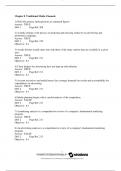Summary
Summary Urban Geography 225 Summaries
- Course
- Institution
- Book
An integrated summation of works from the textbook, my own interpretation as well as some additions from the lecturer and past students of the module. Well rounded and good for test study and exam preparation.
[Show more]





